.
13.05.2016
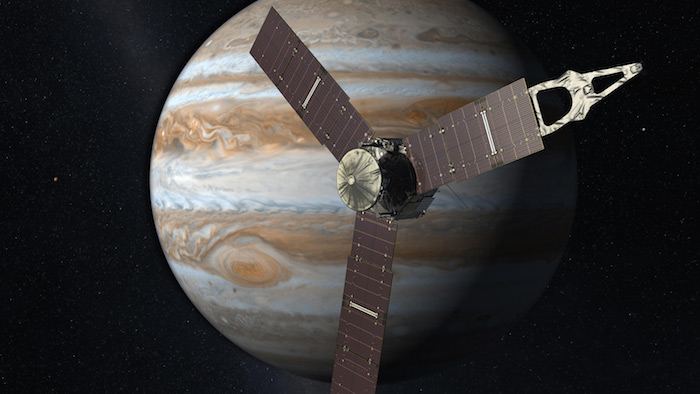
Amateurs prepare big-picture perspective to support Juno mission
Some of the world’s leading amateur and professional astronomers are meeting on 12-13 May to prepare for a campaign of ground-based global observations in support of NASA’s Juno mission to Jupiter. Juno arrives on 4th July this year and will investigate Jupiter through a series of long elliptical orbits with close flybys of the giant planet. To put these observations into perspective and to understand Jupiter’s atmospheric dynamics, the Juno project on behalf of NASA has requested the collaboration of amateur astronomers back on Earth. High-resolution observations obtained by amateur astronomers will allow Juno mission scientists to characterise the state and evolution of Jupiter’s atmosphere over the course of the mission, which is due to end in February 2018.
A workshop to coordinate ground-based support for Juno from amateurs is being held at the Observatoire de la Côte d’Azur in Nice, France, and organised as part of Europlanet 2020 Research Infrastructure’s networking activities. The 29 participants include 13 planetary scientists and 16 amateur astronomers from 13 countries in Europe and around the world, including Romania, Slovenia, USA, Japan and the Philippines.
“The collaborative effort between Juno and amateurs is linked to JunoCam, the mission’s visual camera,” explained Ricardo Hueso, chair of the workshop’s scientific organising committee. “JunoCam, JIRAM and MWR will obtain close up views in the visible, infrared and radio of Jupiter’s upper clouds over relatively small areas of the planet, some of them around the size of the atmospheric storms that we see as the oval features in Jupiter’s cloud bands. This opens an exciting opportunity for amateurs to provide a unique dataset that will be used to plan the high-resolution observations from JunoCam, and will advance our knowledge of the atmospheric dynamics of Jupiter.”
Juno is the first mission dedicated to Jupiter exploration since the Galileo mission in the 1990s. One of its primary goals is to study Jupiter’s gravitational field, inner structure and deep atmospheric composition in order to understand the origin and evolution of the planet.
Jupiter has the fastest rotation of any planet in our Solar System, with its day lasting less than 10 hours. Amateur astronomers at different locations around the globe are able to observe Jupiter continuously and monitor how events, such as storms or cloud stripes, evolve through the planet’s atmosphere. For nearly a decade, amateur astronomers collaborating from America, Europe and Asia have created high-resolution maps of Jupiter’s upper atmosphere, which are updated every few days. Over most of the 20 months of the Juno mission, the amateur contributors will observe the same areas of the planet repeatedly and obtain a long-term global view of changes in the atmosphere, such as the intensity of the winds and the activity of storms in the planet.
Christopher Go, a leading amateur astronomer from the Philippines, said, “I’ve been imaging Jupiter since 2004 and have worked for many years to develop collaborations between amateur and professional astronomers. Amateurs have the advantage in that they don’t have to apply for telescope time, and the equipment now available means that we can make very high-quality observations. I am delighted that the amateur community has been invited to collaborate on Juno and excited at the opportunity to make an important contribution to the mission.”
Glenn Orton from JPL, who is responsible for coordinating Juno observations with Earth-based observations of Jupiter’s atmosphere, said, “Amateur observations can provide continuous monitoring of the atmosphere, creating a fluid documentation of the evolution of atmospheric features. This is particularly important during the active-mission phase because Juno’s remote-sensing observations will cover all latitudes from pole to pole, but they will be confined to narrow strips of longitude, except close to the poles themselves.”
Images
.
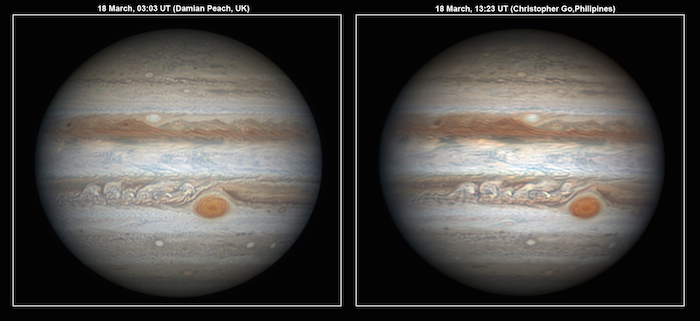
Scientists expect to characterize the state of Jupiter’s atmosphere from high-resolution observations obtained by amateur astronomers. By comparing images of Jupiter obtained from different locations on Earth over time, they can observe the same areas of the planet repeatedly and obtain information such as the intensity of the winds and the activity of storms in the planet. The image on the left was obtained using a 40 cm diameter telescope and a fast black and white camera equipped with colour filters by Damian Peach during a trip to Barbados. The image on the right was obtained by Christopher Go from the Philippines using similar equipment. Credit: D. Peach/C. Go
.
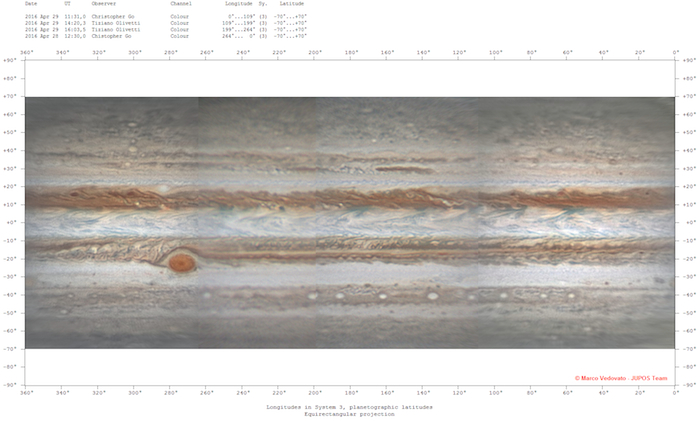
Amateur astronomers regularly analyze their own observations and many participate in studies of the atmosphere of Jupiter. This image shows a nearly full map of Jupiter compiled by the Italian amateur astronomer, Marco Vedovato, from observations obtained by Tiziano Olivetti in Thailand, Christopher Go in the Philippines, and Alexei Pace in Malta. Full maps like this are only possible through the collaboration from observers around the world. The composition of these images by other amateurs like Marco Vedovato helps scientists in their effort to characterize the dynamic atmosphere of Jupiter. Credit: M. Vedovato/T. Olivetti/C. Go/A. Pace
Quelle: euroPLANET
-
Update: 28.05.2016
.
Juno Mission fühlt Jupiter Gravitations Hug
When we send spacecraft into the solar system, they feel the gravitational pull of the sun and the planets. Space scientists will even use the gravity of the planets to sling-shot their robotic spacecraft into deep space.
In the case of NASA's next mission to Jupiter, which has been coasting through space since its launch on Aug. 5, 2011, it has used Earth as a valuable gravity boost and been guided on its orbit by the sun's gravitational field. But as of tomorrow, the most dominant gravity Juno will feel will be Jupiter's and it will stay that way until its mission ends."Today the gravitational influence of Jupiter is neck and neck with that of the sun," said Rick Nybakken, Juno project manager at NASA's Jet Propulsion Laboratory in Pasadena, Calif., in a NASA news release. "As of tomorrow, and for the rest of the mission, we project Jupiter's gravity will dominate as the trajectory-perturbing effects by other celestial bodies are reduced to insignificant roles."
In other words, Jupiter is all there is for Juno from here on in; the gravities of other celestial bodies, particularly the sun, will fade into nothing more than a distant whimper and Jupiter will now be in the orbital driving seat.
This gravity "handover" is the beginning of some big changes for Juno. On July 4 it will commence its orbital insertion maneuver around the gas giant, carrying out a jarring 35 minute main engine burn that will slow the speeding spacecraft down by 1,212 mph (or 542 meters per second), allowing Jupiter's gravity to guide Juno into its new orbital home. But this isn't a comfortable new home -- the orbit of Jupiter is wrought with radiation hazards and, though Juno has some complex shielding, this will inevitably take its toll and ultimately puts a shelf-life on the mission's duration.
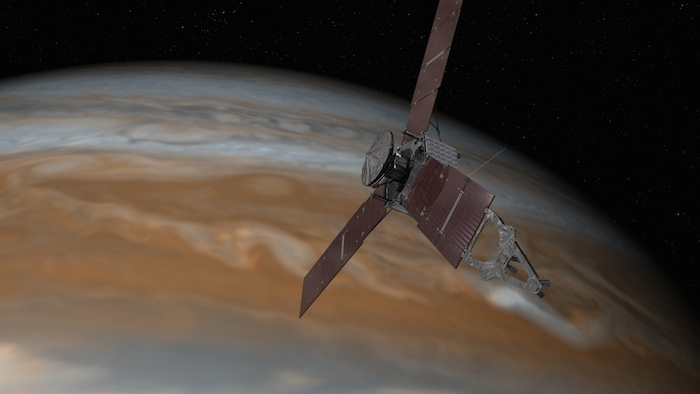
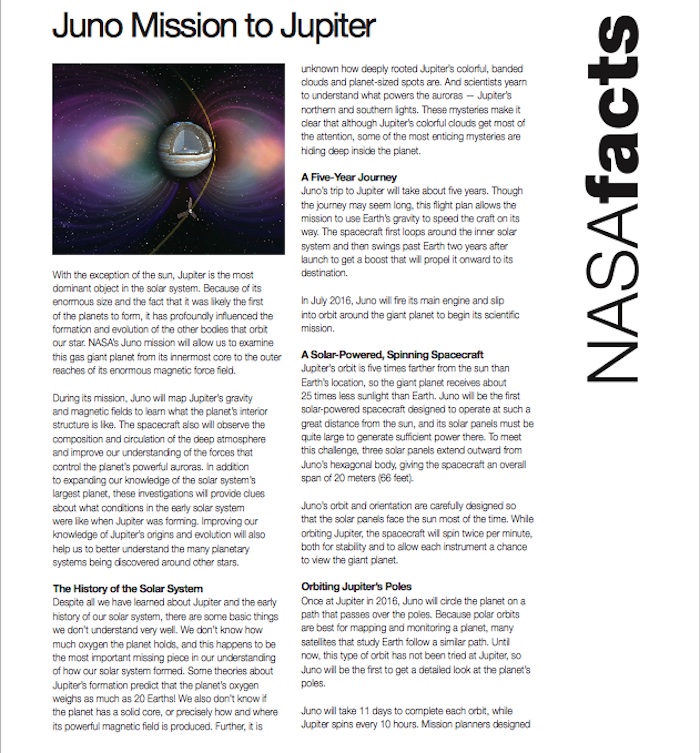
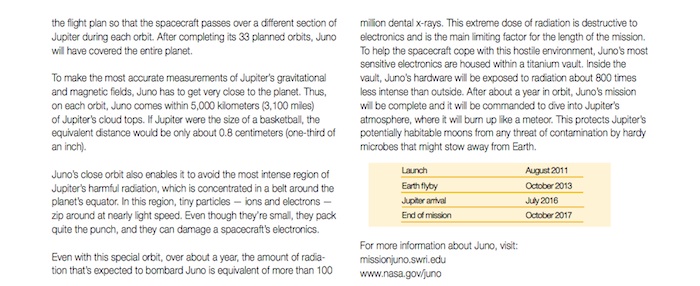
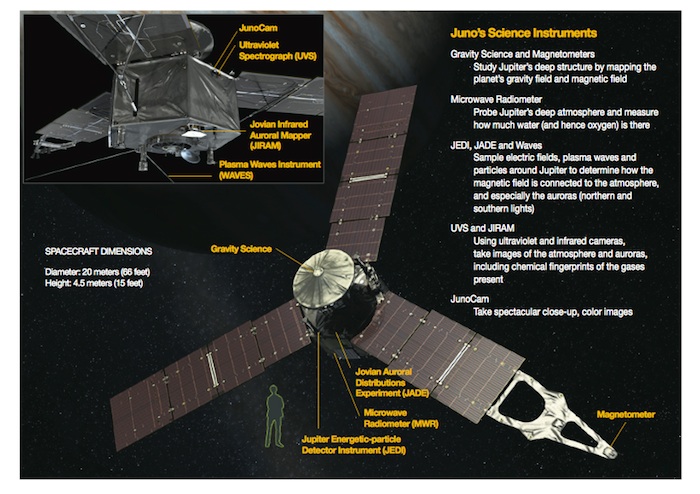
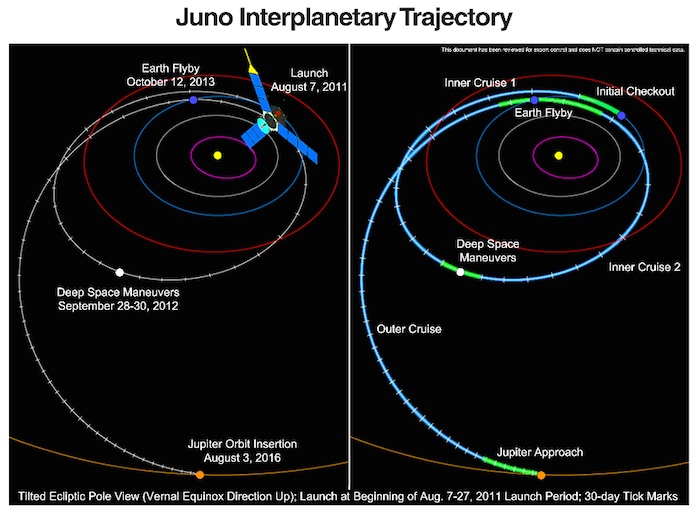

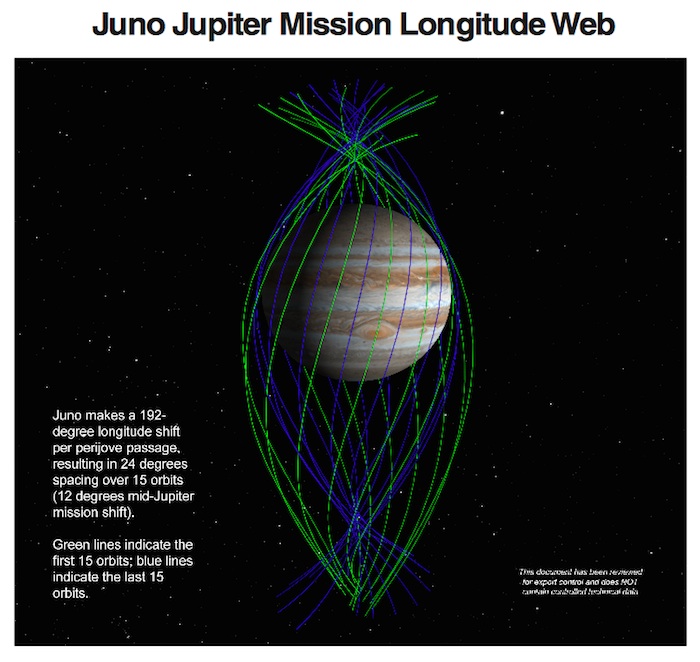
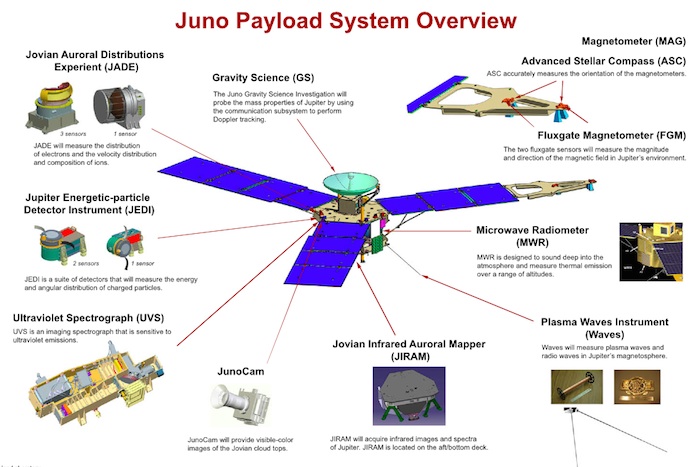
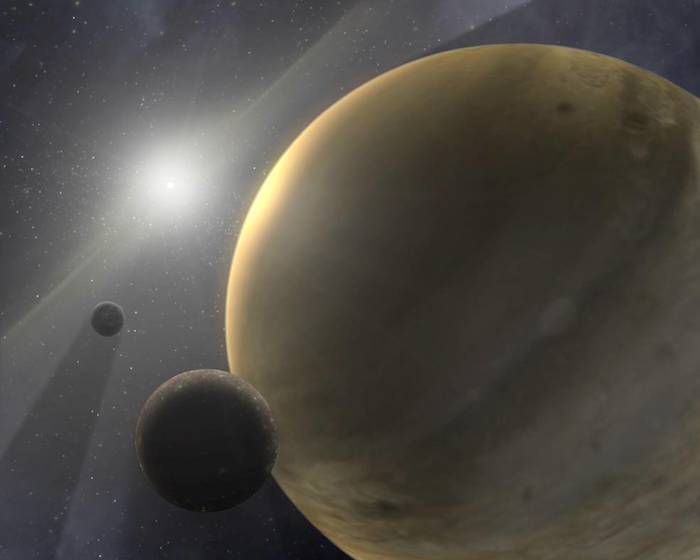
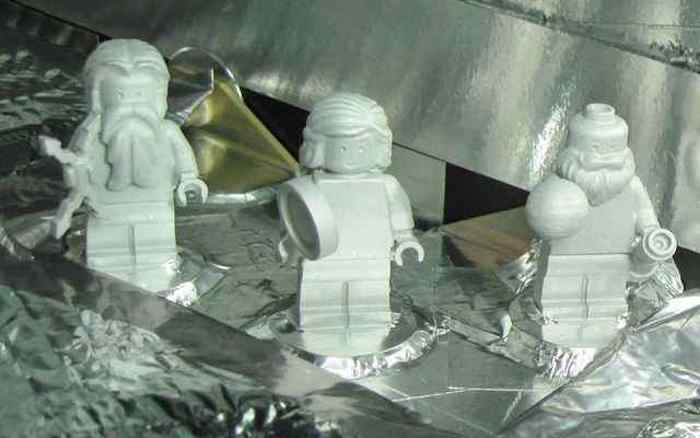
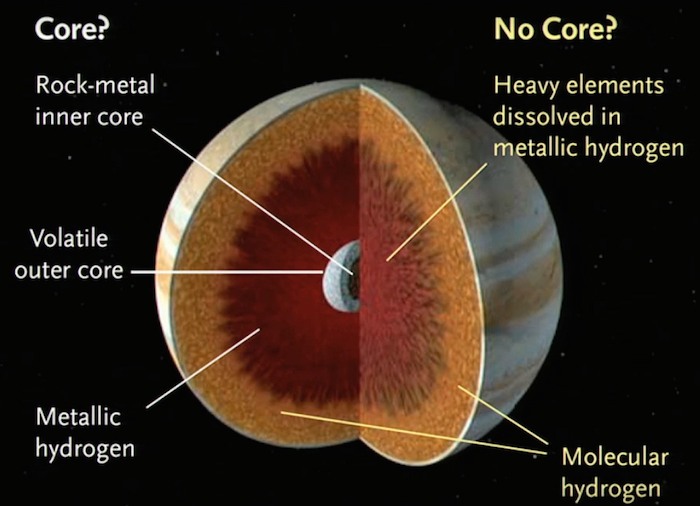
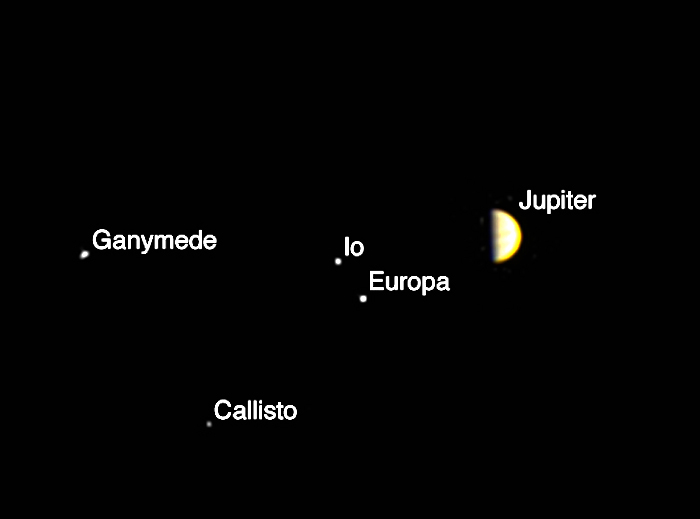
Its primary mission will see Juno orbit Jupiter 37 times, coming within 3,100 miles of the planet's cloud tops. The mission will make incredibly precise measurements of the planet's atmosphere and magnetic field, probing into the underlying physics of Jupiter's supercharged auroras. This is all in an effort to understand how this planetary giant formed and evolved into its current state.
But as with all missions deep within the solar system, we're also looking back on ourselves, trying to piece together the giant jigsaw puzzle about how Earth formed in the way that it did and, ultimately, add another layer of understanding as to how life -- particularly life intelligent enough to propel robots across interplanetary space -- was sparked.
Since NASA's Galileo mission, which ended in 2003, we haven't had a spacecraft at the gas giant. Now that's soon to change and it's exciting to anticipate what incredible science Juno will uncover.
Quelle: See-er
-
Update: 5.06.2016
.
A planet on steroids. How Juno could solve the riddle of Jupiter
The largest planet in the solar system may finally give up its secrets thanks to a new probe
A few days from now, a US spacecraft carrying a 200kg titanium vault crammed with delicate electronic equipment and fitted with a vast array of solar panels will sweep over the poles of Jupiter before entering into orbit around the giant planet. The craft, named Juno, has travelled almost three billion kilometres since it was launched in 2011. For the next two years, the huge spaceship will skim over Jupiter’s thick atmosphere while trying to avoid the planet’s huge belts of deadly radiation in a bid to uncover the secrets of this mysterious, remote world.
The $1.1bn (£757,837m) mission is designed to peer deep into the thick layers of gases that make up the planet’s atmosphere and return data that could be crucial to understanding the birth not just of Jupiter but of all the planets in our solar system, including Earth.
It will be an extraordinarily delicate task, however. Juno will have to travel extremely close to Jupiter’s powerful magnetic field and radiation belts, and these could easily destroy its instruments. “That is why we have fitted the spacecraft with a titanium vault – to protect the probe’s electronics,” said Juno’s principal investigator, Scott Bolton of the Southwest Research Institute in San Antonio, Texas. “This is a mission with fantastic potential,” he added. “The trouble is that Jupiter is a planet on steroids. Everything about it is massive and that poses real problems for Juno. It will have to weave its way round Jupiter on a very, very delicate path.”
Jupiter is more massive than all the other objects – planets, moons, asteroids and comets – in the solar system, with the exception of the Sun itself. It is also believed to be the first planet created when the solar system formed 4.6 billion years ago. “It appeared first and was then able to scoop up most of the loose material that was sweeping round the Sun then. That is how it got to be so big,” said Bolton.
Understanding Jupiter’s creation is therefore crucial to understanding the formation of the rest of the solar system. However, the planet, which is 317 times bigger than the Earth, is not easy to study. Its magnetic field is the most powerful of any known planet and catches high-energy particles as they fly through space, trapping them in two vast radiation belts that surround it. These are similar to Earth’s Van Allen belts but are many millions of times more intense. Any satellite that strayed into them would find its electronic circuits fried.
“That makes life very difficult for Juno,” said Bolton. “We need to get close to Jupiter to be able to probe its atmosphere – but that means getting close to its radiation belts. We are going to have to fly very carefully or its instruments will be destroyed by radiation.”
This is only one of the many headaches that the spaceship’s designers have had to overcome, however. Juno will also have to carry out its tricky interplanetary manoeuvres on an incredibly tight power budget: the craft’s solar panels will be able to generate a few hundred watts of electricity, sufficient to power a couple of electric light bulbs, and not much more.
In the past, spacecraft sent to study planets far from the Sun have used generators powered by radioactive isotopes. “However, when we were designing and building Juno in the early 21st century, Nasa had temporarily run out of isotopes and so we have had to rely on solar power,” said Bolton.
And given Jupiter’s distance, that is a tricky issue. The planet orbits at 780m km from the Sun. The Earth, by comparison, orbits a mere 150m km from the Sun, which means that sunlight here is 25 times more powerful than it is at Jupiter.
Just after launch, when Juno was still close to the Earth, its giant solar panels – some of the biggest fitted to a planetary probe – could generate around 12 kilowatts of power. Now, as it approaches deep space near Jupiter, that has dropped to just over 400 watts.
Nevertheless, Bolton said he was confident that Juno could operate at such power levels. “The spacecraft is extremely efficient. Its instruments have been designed to run on that kind of power,” he said.
As to those instruments, they have been built to study Jupiter’s atmosphere in unprecedented detail, and to solve several key puzzles about the giant planet.
In 1995 Galileo – the only spacecraft that has orbited Jupiter to date – dropped a 339kg probe into the planet’s atmosphere. As it descended, the probe transmitted details about the various elements it encountered – and found several unexpected features. In particular, it found that most of the elements, such as carbon and nitrogen, in Jupiter’s atmosphere exist at enriched levels with one key exception – oxygen was found to be at surprisingly low levels.
“We had expected to see oxygen, in the form of water which contains oxygen, but saw very little,” said Bolton. “There are two explanations for this. One is that we simply do not understand Jupiter properly at all. The alternative explanation is that we were really, really unlucky and picked the one part of the planet that had no water in it. We’d hit Jupiter’s Sahara desert – through sheer bad luck.”
Juno is designed to discover which of these ideas is correct. “We need to find what the rest of Jupiter has got in it. That is what Juno is about,” added Bolton. “We are going to look all over the place and at much greater depths than we did in 1995.”
This task will be achieved not by dropping a probe but by relying on Juno’s microwave antennae. “Jupiter emits microwaves. It glows with them,” said Bolton.
“And, crucially, microwaves interact with water. That is why your microwave oven heats up wet spaghetti. Similarly, in Jupiter’s atmosphere microwaves are interacting with water and by studying what microwaves are being emitted, we can work out how much water – and oxygen – exists and at what depths.”
Juno is designed to make 37 orbits of Jupiter over its scheduled 20-month lifetime and will skim within 3,000 miles of the top of the planet’s atmosphere while trying to dodge its radiation belts, and all on a power budget of a few hundred watts.
“It is going to be a very risky mission but a worthwhile one,” added Bolton. “Frankly, if Juno survives two years of that kind of treatment before its electronics get burned up we will be very happy.”
Juno is now on the home stretch on its route to Jupiter. “For the rest of the mission, we project that Jupiter’s gravity will dominate as the trajectory-perturbing effects of other celestial bodies are reduced to insignificant roles,” said Rick Nybakken, Juno’s project manager.
On 4 July the spacecraft will finally reach its target. “And that is when the really tricky stuff starts,” added Bolton.
Quelle: theguardian
-
Update: 8.06.2016
.
Juno’s Mission to Jupiter May Also Reveal Clues about Exoplanets
NASA’s interplanetary probe is cruising toward an encounter with our local gas giant this summer. As the data starts flowing in, we may also learn about Jupiter’s many cousins across the galaxy
.
A new spacecraft is en route to the king of planets. NASA’s Juno mission will arrive at Jupiter July 4 to study our solar system’s largest world up close and personal. Once its primary mission starts around November, Juno will spend at least a year and a half examining the planet's interior and weather. But some scientists are interested not in what Juno can tell us about Jupiter but in what it could reveal about planets much farther away. They hope that in gathering such detailed information about our own gas-giant planet, Juno will help reveal how giant worlds beyond our own solar system were born and behave.
Scientists have already discovered hundreds of Jupiter-size planets circling other stars, and suspect those are just the tip of the iceberg. Some are known as “hot Jupiters,” because their tight orbits around their parent stars raise them to scorching temperatures. Other Jupiters circle in highly eccentric—that is, oblong—orbits, which is again unlike our own neighborhood. No one knows why some planets end up in such eccentric or close orbits whereas others—like Jupiter—revolve in relatively circular paths and from farther distances.
One theory is that planets start in different orbits and migrate over time. Juno will look for hints that Jupiter may have formed somewhere else than it is now by determining if there is less water and oxygen inside the planet than is likely if its building blocks came from its current location in the solar system. If so, the planet may have formed farther out from the sun where the environment is colder and later traveled inward. Such a finding would have implications for models predicting the formation of other gas giants in other systems. It is unlikely, however, that Jupiter has migrated very far, Juno principal investigator Scott Bolton of the Southwest Research Institute says, and he cautioned that the spacecraft will not be able to do a direct test of orbital migration, because whatever scientists learn about Jupiter’s interior, several formation scenarios may still be in play. “One theorist may update the model based on that [new] data by moving Jupiter out,” he says, “but somebody else may change the [formation] conditions and keep Jupiter where it's at.” [See a slide show of Juno’s mission to Jupiter]
Scientists have similar questions about whether most of the gas-giant exoplanets they see formed in their current locations or moved around. Hot Jupiters, for example, do not seem likely to have formed where they are because at such proximity to stars, most of the planet-building material would have been scarce, theories suggest. Likewise, researchers have trouble understanding how gas giants can form extremely far away from their stars because of a similar lack of building blocks. Juno's data could therefore help scientists better understand how exoplanetary systems got their layouts, says Jack Lissauer, a staff scientist at NASA Ames Research Center. Any evidence that Jupiter has migrated could support the idea that other giant planets are also likely to migrate.
Such investigations will be just part of Juno’s efforts to learn more about what Jupiter is made of. Despite 400 years of telescopic observations of the giant planet and 40 years of periodic close-up spacecraft studies, researchers still understand little about Jupiter's formation history. Basic mysteries on whether the planet has a core—and if it does have one, the size—as well as how much water the Jovian interior holds stymie scientists.
Unlike past spacecraft sent to Jupiter, Juno is equipped with a microwave radiometer, an instrument that can measure how water vapor contributes to refracting the atmosphere at microwave frequencies, to look beneath the cloud tops to study water content and weather processes. The spacecraft will also measure Jupiter's magnetic and gravity fields with greater precision than its predecessor, Galileo, which studied the planet and its moons between 1995 and 2003, because it will circle the planet in a polar orbit that allows it to get closer to the planet.
Juno’s measurements of Jupiter’s magnetic field could also give insights into the planet’s internal structure. Scientists hope to learn whether deep down a core of heavy elements exists or whether the hydrogen and helium atmosphere goes “all the way down” until the elements compress at the center, Bolton says. Such a core could be helping to generate Jupiter’s magnetic field, but is not required. Scientists can also tackle the question of a core via Juno’s measurements of the planet’s gravitational field because gravitational structure can reflect the convection of heat deep inside, where the pressure is so high that compressed hydrogen acts like a molten metal.
If there is no core at all, Jupiter may have formed similarly to the sun—that is to say it may have gradually coalesced from the “protoplanetary nebula” of gas and dust that birthed our solar system. If researchers do find a core, however, that might indicate that heavy elements floating around when the solar system formed first coalesced into planet-size chunks, which then could have attracted floating gas molecules to create the giant planets Jupiter, Saturn, Uranus and Neptune.
Of course, just because scientists may get clues into how Jupiter formed does not mean they will necessarily know how other gas-giant exoplanets formed, but it is likely that our own giant planet is fairly representative, Bolton says. Jupiter, for instance, is mostly composed of hydrogen and helium, which are the elements that make up most of our solar system as well as most interstellar clouds that collapse to form other solar systems.
For the foreseeable future Juno’s observations will provide the best possible look at what a giant planet's atmosphere is made of, said Raymond Jeanloz, an astronomy professor at the University of California, Berkeley, who studies planetary interiors. For exoplanetary researchers, however, Juno has a key limitation: It is only looking at a single world. There are thousands of known exoplanets too far away for a spacecraft to visit. Scientists are looking forward to two forthcoming space telescopes to measure the atmospheres of many giant planets: the James Webb Space Telescope and the Wide-Field Infrared Survey Telescope (WFIRST). "We are right now just barely getting our first glimpses at atmospheres” with current telescopes, says Heather Knutson, an assistant professor at the California Institute of Technology who studies exoplanetary atmospheres. “With JWST, we will see everything in beautiful detail.” WFIRST's advantage is it will be able to view planets without the overwhelming shine of their stars drowning their own light out, due to a “coronograph” that blocks the stars’ light, she adds.
Juno will spend its first 107 days at Jupiter completing two long orbits to calibrate its instruments and then maneuver to adjust its orbital period to 14 days. The probe will then complete at least 33 of these orbits, which will allow mission scientists to eventually create a full map of Jupiter's cloud tops and also probe beneath their surface. Funding could extend the mission slightly but the intense radiation environment of Jupiter will gradually damage Juno’s instruments and eventually force scientists to deliberately plunge the spacecraft into Jupiter before it is debilitated to the point it cannot be controlled. This measure will prevent any accidental impacts on icy and potentially life-friendly moons nearby, such as Europa, protecting them from chemical contamination by propellants as well as Earth microbes that may have hitched a ride on the spacecraft.
Quelle: ScientificAmerican
.
Update: 9.06.2016
.
NASA’s Juno Mission 26 Days from Jupiter
JUNO MISSION STATUS

NASA's Juno mission is now 26 days and 11.1 million miles (17.8 million kilometers) away from the largest planetary inhabitant in our solar system -- Jupiter. On the evening of July 4, Juno will fire its main engine for 35 minutes, placing it into a polar orbit around the gas giant. It will be a daring planetary encounter: Giant Jupiter lies in the harshest radiation environment known, and Juno has been specially designed to safely navigate the brand new territory.
We're currently closing the distance between us and Jupiter at about four miles per second," said Scott Bolton, principal investigator for Juno from the Southwest Research Institute in San Antonio. "But Jupiter's gravity is tugging at us harder every day and by the time we arrive we'll be accelerated to 10 times that speed -- more than 40 miles per second (nearly 70 kilometers per second) -- by the time our rocket engine puts on the brakes to get us into orbit."
The Juno mission team is using these last weeks to evaluate and re-evaluate every portion of the Jupiter orbit insertion (JOI) process, finding very low probability events and running them to ground -- determining which, if any, need to be addressed. Two scenarios have been identified for further work. The first is a variation in how Juno would come out of safe mode—a protective mode if the spacecraft were to encounter an anomaly or unexpected condition. A second item involves a minor software update.
"We are in the last test and review phases of the JOI sequence as part of our final preparations for Jupiter orbit insertion," said Rick Nybakken, project manager of Juno for NASA's Jet Propulsion Laboratory in Pasadena, California. "Throughout the project, including operations, our review process has looked for the likely, the unlikely and then the very unlikely. Now we are looking at extremely unlikely events that orbit insertion could throw at us."
Quelle: NASA
-
Update: 12.06.2016
.



---




Juno Overview
Unlocking Jupiter's Secrets
Juno will improve our understanding of the solar system's beginnings by revealing the origin and evolution of Jupiter.
Specifically, Juno will…
Determine how much water is in Jupiter's atmosphere, which helps determine which planet formation theory is correct (or if new theories are needed)
Look deep into Jupiter's atmosphere to measure composition, temperature, cloud motions and other properties
Map Jupiter's magnetic and gravity fields, revealing the planet's deep structure
Explore and study Jupiter's magnetosphere near the planet's poles, especially the auroras – Jupiter's northern and southern lights – providing new insights about how the planet's enormous magnetic force field affects its atmosphere.
The Giant Planet Story is the Story of the Solar System
Juno's principal goal is to understand the origin and evolution of Jupiter. Underneath its dense cloud cover, Jupiter safeguards secrets to the fundamental processes and conditions that governed our solar system during its formation. As our primary example of a giant planet, Jupiter can also provide critical knowledge for understanding the planetary systems being discovered around other stars.
With its suite of science instruments, Juno will investigate the existence of a solid planetary core, map Jupiter's intense magnetic field, measure the amount of water and ammonia in the deep atmosphere, and observe the planet's auroras.
Juno will let us take a giant step forward in our understanding of how giant planets form and the role these titans played in putting together the rest of the solar system.
Jupiter's Origins and Interior
.

Artist concept of a young star system similar to our own.
Credits: NASA/JPL-Caltech
T. Pyle (SSC) Theories about solar system formation all begin with the collapse of a giant cloud of gas and dust, or nebula, most of which formed the infant sun. Like the sun, Jupiter is mostly hydrogen and helium, so it must have formed early, capturing most of the material left after our star came to be. How this happened, however, is unclear. Did a massive planetary core form first and gravitationally capture all that gas, or did an unstable region collapse inside the nebula, triggering the planet's formation? Differences between these scenarios are profound.
Even more importantly, the composition and role of icy planetesimals, or small proto-planets, in planetary formation hangs in the balance – and with them, the origin of Earth and other terrestrial planets. Icy planetesimals likely were the carriers of materials like water and carbon compounds that are the fundamental building blocks of life.
Unlike Earth, Jupiter's giant mass allowed it to hold onto its original composition, providing us with a way of tracing our solar system's history. Juno will measure the amount of water and ammonia in Jupiter's atmosphere and determine if the planet actually has a solid core, directly resolving the origin of this giant planet and thereby the solar system. By mapping Jupiter's gravitational and magnetic fields, Juno will reveal the planet's interior structure and measure the mass of the core.
Atmosphere
How deep Jupiter's colorful zones, belts, and other features penetrate is one of the most outstanding fundamental questions about the giant planet. Juno will determine the global structure and motions of the planet's atmosphere below the cloud tops for the first time, mapping variations in the atmosphere's composition, temperature, clouds and patterns of movement down to unprecedented depths.
Magnetosphere
Deep in Jupiter's atmosphere, under great pressure, hydrogen gas is squeezed into a fluid known as metallic hydrogen. At these great depths, the hydrogen acts like an electrically conducting metal which is believed to be the source of the planet's intense magnetic field. This powerful magnetic environment creates the brightest auroras in our solar system, as charged particles precipitate down into the planet's atmosphere. Juno will directly sample the charged particles and magnetic fields near Jupiter's poles for the first time, while simultaneously observing the auroras in ultraviolet light produced by the extraordinary amounts of energy crashing into the polar regions. These investigations will greatly improve our understanding of this remarkable phenomenon, and also of similar magnetic objects, like young stars with their own planetary systems.
Learn more about the motivation behind Juno at the mission website.
Juno's Mythical Connection
In Greek and Roman mythology, Jupiter drew a veil of clouds around himself to hide his mischief. It was Jupiter's wife, the goddess Juno, who was able to peer through the clouds and reveal Jupiter's true nature. The Juno spacecraft will also look beneath the clouds to see what the planet is up to, not seeking signs of misbehavior, but helping us to understand the planet's structure and history.
Mission Timeline
Launch - August 5, 2011
Deep Space Maneuvers - August/September 2012
Earth flyby gravity assist - October 2013
Jupiter arrival - July 2016
Spacecraft will orbit Jupiter for 20 months (37 orbits)
End of mission (deorbit into Jupiter) - February 2018
The Juno mission is the second spacecraft designed under NASA's New Frontiers Program. The first is the Pluto New Horizons mission, which flew by the dwarf planet in July 2015 after a nine-and-a-half-year flight. The program provides opportunities to carry out several medium-class missions identified as top priority objectives in the Decadal Solar System Exploration Survey, conducted by the Space Studies Board of the National Research Council in Washington.
JPL manages the Juno mission for the principal investigator, Scott Bolton, of Southwest Research Institute in San Antonio. The Juno mission is part of the New Frontiers Program managed at NASA's Marshall Space Flight Center in Huntsville, Ala. Lockheed Martin Space Systems, Denver, built the spacecraft. Launch management for the mission is the responsibility of NASA's Launch Services Program at the Kennedy Space Center in Florida. JPL is a division of the California Institute of Technology in Pasadena.
Quelle: NASA
---
Why NASA sent 3 defenseless Legos to die on Jupiter

Special LEGOs of the Roman gods Jupiter and Juno, and one modeled after the likeness of Galileo Galilei.
In less than two years, NASA will send three unique Lego Minifigures to their fiery deaths in Jupiter’s atmosphere.
It will make the only other set in the universe — a prized possession at NASA’s Jet Propulsion Laboratory — much more valuable.
But fear not, the two Lego men and one Lego woman will be sacrificed in the name of science. The aluminum figurines of astronomer Galileo, Roman god Jupiter and goddess Juno are aboard a deep-space probe that’s been heading to the gas giant for the last five years.
The spacecraft, named after Juno, will peer through Jupiter’s cloudy atmosphere in an attempt to understand the origins of the largest planet in our solar system. When the probe completes its mission in 2018, it will fly into Jupiter and burn up.
Juno’s Principal Investigator Scott Bolton came up with the idea to include the Minifigures aboard the spacecraft to inspire and connect children with the mission. He thought Lego would make the perfect partner because of the toy manufacturer’s commitment to education.
“It was just me making a cold call,” Bolton said.
NASA and Lego have collaborated before. They’ve sent Legos to the International Space Station and to Mars. But the trip to Jupiter will be the furthest a Lego man or woman has ever traveled in our universe.
Lego created two sets of figures specifically for the mission. One was a backup in case the first set broke. While the same size as store-bought Minifigures, these Legos are made out of aluminum to protect them from the harshness of space. “They had to be made of the same material the spacecraft is made of,” Bolton said.
NASA secured the trio beneath the spacecraft’s thermal protection.
In Roman mythology, Jupiter would use clouds to hide his mischief, but his wife, Juno, would peer through his screen from atop Mount Olympus. Lego Juno holds a magnifying glass, while Jupiter holds a lightning bolt. The third figurine represents Galileo Galilei, the Italian astronomer, who determined that the Earth revolves around the sun, and not the other way around. Galileo, in part, determined this after observing Jupiter’s four moons orbiting the gas giant.
His Lego carries a telescope and a globe.
Bolton said he would love to see the three Minifigures become commercially available. He loans JPL’s backup set to museums and takes them on school tours, he said. Lego also sent a three-foot Lego duplicate of the Juno spacecraft to Bolton and JPL.
On July 4, when Juno fires its engines to enter Jupiter’s orbit, the three backup Legonauts will be in NASA JPL’s mission control room to make sure everything goes right.
And maybe they’ll breathe a little sigh of relief too.
Quelle: The San Gabriel Valley Tribune
-
Update: 14.06.2016
.
NASA Spacecraft Closing in on Jupiter, Media Briefing to Discuss July 4 Arrival
NASA will host a media briefing at 2 p.m. EDT on Thursday, June 16, to discuss the agency’s Juno spacecraft and its July 4th arrival at Jupiter.
The briefing will be held in the James Webb Auditorium at NASA Headquarters, 300 E Street SW, Washington, and broadcast live on NASA Television and the agency's website.
The solar-powered spacecraft will perform a suspenseful Jupiter orbit insertion maneuver -- a 35-minute burn of its main engine -- which will slow Juno by about 1,200 mph (542 meters per second) so it can be captured into the gas giant’s polar orbit. Juno will loop Jupiter 37 times during 20 months, skimming to within 3,100 miles (5,000 kilometers) above its swirling cloud tops.
Juno will provide answers to ongoing mysteries about Jupiter’s core, composition and magnetic fields, and provide new clues about the origins of our solar system.
The briefing participants will be:
· Diane Brown, Juno mission program executive, NASA Headquarters, Washington
· Scott Bolton, Juno principal investigator, Southwest Research Institute, San Antonio
· Rick Nybakken, Juno project manager, Jet Propulsion Laboratory (JPL), Pasadena, California
· Heidi Becker, radiation monitoring investigation lead, JPL
· Alberto Adriani, Juno co-investigator, Instituto di Astrofisica e Planetologia Spaziali, Rome
Media may ask questions during the event on site and by phone. Members of the public also can ask questions on social media using #AskNASA.
To participate in the briefing by phone, media must email their name, media affiliation and phone number to Laurie Cantillo at laura.l.cantillo@nasa.gov by 1 p.m. Thursday.
Quelle: NASA
-
Update: 16.06.2016
.
We’ve been to Jupiter before but haven’t looked into its mysterious soul
The $1.1 billion Juno mission has just one chance to get into orbit at the gas giant.
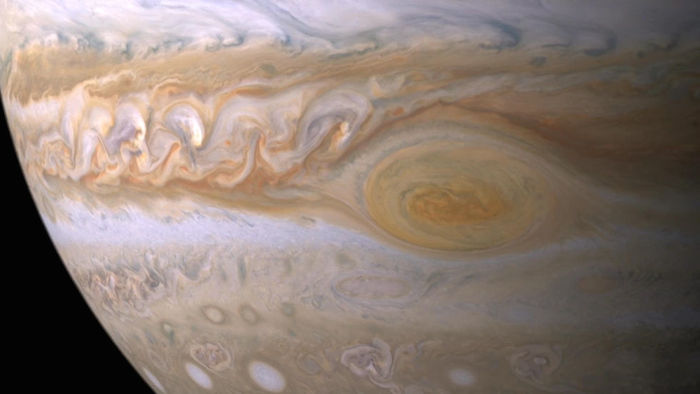
At first blush Jupiter may seem like a rather dull planet. A failed star. A ball of gas. A large, red storm. Sure, it's big, but what more is there? And we’ve been there before—lots of times, in fact. Beginning with Pioneer 11 and 12, NASA has flown seven probes by the gas world. One mission, Galileo, studied the Jovian system for nearly a decade from 1995 to 2003. So why is the space agency sending yet another probe, Juno, to once again visit the Solar System's giant?
We're still studying Jupiter because despite all of these missions, NASA has literally only scratched the surface. Its inner structure remains largely a mystery—and an intriguing one, too. The planet is essentially made of gas piled upon more gas. And like a big stack of pillows, as more gas is added on top, the bottom layers become more and more compressed as gravity pulls down on the gas. This creates extremely dense conditions inside the planet. Jupiter, after all, is only a little bit larger than Saturn—but it has three times the mass. Scientists have almost no idea how hydrogen will behave at the extreme pressures deep beneath Jupiter's outer layers toward its core. Indeed, does Jupiter even have a core? We simply don’t know.
The Juno spacecraft, launched in 2011 and arriving at Jupiter on July 4 this year, will be able to scrutinize the planet's gravity field and peer beneath its upper cloud layer. This should help offer some clarity about Jupiter’s interior. During a presentation in May at the Lunar and Planetary Institute in Houston, mission scientist Fran Bagenal discussed just how strange that interior might be.
Metallic hydrogen
The exterior of Jupiter is gaseous and cold, with a temperature of about -150 degrees Celsius. The temperature and density increase rapidly as one goes into the planet, and when the temperature reaches about 1,700 degrees Celsius, hydrogen is forced into a liquid because of the accompanying pressure at that depth. Just a little bit further down—still only about 20 percent of the distance from the surface to the center—the temperature becomes high enough that the bonds of the hydrogen molecules begin to break down. And from there, down to the center of the planet where temperatures reach about 20,000 degrees Celsius, things get really weird.
It’s not clear what the combination of pressure and temperature (four or five times hotter than the surface of the Sun) will do to hydrogen. To get a sense of the pressure on atoms at the center of Jupiter, Bagenal conjured an image of an elephant standing on one foot. Now imagine 1,000 elephants standing on top of that one elephant. And even that doesn’t approximate the pressure in the interior of Jupiter, which is 100 million times the atmospheric pressure on Earth. That one elephant would need to be standing in a stiletto heel.
“We don’t really know how hydrogen behaves at those pressures,” she said. “We are sort of making it up. We are working at a realm where we don’t have experimental evidence. So we have to rely on theorists to tell us what happens.”
Scientists have taken hydrogen to a couple million times the pressure of the planet’s surface in Earth-based experiments, and at these high pressures the bonds of molecular hydrogen break to create a conductive fluid of protons and electrons known as metallic hydrogen. This fluid might be something like the liquid mercury in thermometers. But what happens at the much higher pressures inside Jupiter?
.

Does Jupiter have a core, or not?
-
Bagenal said this truly represents the cutting edge of science. When Juno launched five years ago, theorists generally believed Jupiter had a core of heavier elements such as oxygen and carbon beneath a layer of metallic hydrogen. However, physicists working with quantum mechanical models of hydrogen say they now expect the heavier elements to be all mixed up in the metallic hydrogen soup. Bagenal hopes the answers to this mystery lie in studying the gravitational field of Jupiter.
The spacecraft
Named after the Roman goddess who was both sister and wife to Jupiter, the $1.1 billion Juno mission launched aboard an Atlas V rocket with five solid rocket boosters attached. The spacecraft now approaching Jupiter weighs about 3,600kg and is 3.5 meters long and 3.5 meters wide. It features huge solar panels, measuring a total of 60 square meters, because the solar output is about 25 times weaker at Jupiter than Earth.
In addition to the gravity science experiment mentioned by Bagenal, the mission carries eight other instruments, including a magnetometer and spectrograph. Aside from understanding the planet's mysterious interior, scientists also hope to gather data that will allow them to piece together the formation and evolution of Jupiter as the largest planet in the Solar System and understand the precise mechanism that generates its large magnetic field. Understanding Jupiter’s development should lead to a better overall picture of the Solar System’s formation.
Scientists are not sure how long the spacecraft will survive in the harsh radiation environment generated by Jupiter. Most of Juno’s electronics are housed inside a vault with a thick titanium casing, because the spacecraft will pass repeatedly through the planet’s lethal radiation belts as it travels over the poles. Mission scientists hope to get 33 orbits out of the spacecraft, but Bagenal said they’re not sure its sensitive equipment will last that long. At the end of its mission Juno will maneuver into an orbit that will slowly degrade and eventually allow the spacecraft to be swallowed by Jupiter’s gaseous maw. It will collect no more data in this death spiral, but at least Juno will be kept away from any Jovian moons that might harbor life–such as Europa. At least for the time being, we will continue to attempt no landing there.
For NASA the most critical date in the mission is coming soon: on July 4, Juno will commence its orbital insertion maneuver. Right now, Juno is approaching Jupiter at about 6 km/s relative to the planet. At approximately 10:30pm Pacific time on July 4, the spacecraft will begin a 35-minute burn to slow down and—hopefully—slide into orbit around Jupiter. If all goes well, the spacecraft will begin peering into the clouds of the planet shortly thereafter.
Quelle: ars technica
-
Update: 25.06.2016
.
NASA'S JUNO SPACECRAFT CLOSING IN ON JUPITER

oday (6/24), at exactly 9:57 and 48 seconds a.m. PDT, NASA's Juno spacecraft was 5.5 million miles (8.9 million kilometers) from its July 4th appointment with Jupiter. Over the past two weeks, several milestones occurred that were key to a successful 35-minute burn of its rocket motor, which will place the robotic explorer into a polar orbit around the gas giant.
"We have over five years of spaceflight experience and only 10 days to Jupiter orbit insertion," said Rick Nybakken, Juno project manager from NASA's Jet Propulsion Laboratory in Pasadena, California. "It is a great feeling to put all the interplanetary space in the rearview mirror and have the biggest planet in the solar system in our windshield."
On June 11, Juno began transmitting to and receiving data from Earth around the clock. This constant contact will keep the mission team informed on any developments with their spacecraft within tens of minutes of it occurring. On June 20, the protective cover that shields Juno's main engine from micrometeorites and interstellar dust was opened, and the software program that will command the spacecraft through the all-important rocket burn was uplinked.
One of the important near-term events remaining on Juno's pre-burn itinerary is the pressurization of its propulsion system on June 28. The following day, all instrumentation not geared toward the successful insertion of Juno into orbit around Jupiter on July 4 will be turned off.
"If it doesn't help us get into orbit, it is shut down," said Scott Bolton, Juno's principal investigator from the Southwest Research Institute in San Antonio. "That is how critical this rocket burn is. And while we will not be getting images as we make our final approach to the planet, we have some interesting pictures of what Jupiter and its moons look like from five-plus million miles away."
The mission optical camera, JunoCam, imaged Jupiter on June 21, 2016, at a distance of 6.8 million miles (10.9 million kilometers) from the gas giant. In the image, just to the right of center is Jupiter, with its distinctive swirling bands of orange, brown and white. To the left of Jupiter (from right to left) are the planet's four largest moons -- Europa, Io, Callisto and Ganymede. Juno is approaching over Jupiter's north pole, affording the spacecraft a unique perspective on the Jovian system. Previous missions that imaged Jupiter on approach saw the system from much lower latitudes, closer to the planet's equator.
JunoCam is an outreach instrument -- its inclusion in this mission of exploration was to allow the public to come along for the ride with Juno. JunoCam’s optics were designed to acquire high-resolution views of Jupiter’s poles while the spacecraft is flying much closer to the planet. Juno will be getting closer to the cloud tops of the planet than any mission before it, and the image resolution of the massive gas giant will be the best ever taken by a spacecraft.
All of Juno’s instruments, including JunoCam, are scheduled to be turned back on approximately two days after achieving orbit. JunoCam images are expected to be returned from the spacecraft for processing and release to the public starting in late August or early September.
"This image is the start of something great," said Bolton. "In the future we will see Jupiter's polar auroras from a new perspective. We will see details in rolling bands of orange and white clouds like never before, and even the Great Red Spot.
The Juno spacecraft launched on Aug. 5, 2011, from Cape Canaveral, Florida.
JPL manages the Juno mission for the principal investigator, Scott Bolton, of Southwest Research Institute in San Antonio. Juno is part of NASA's New Frontiers Program, which is managed at NASA's Marshall Space Flight Center in Huntsville, Alabama, for NASA's Science Mission Directorate. Lockheed Martin Space Systems, Denver, built the spacecraft. The California Institute of Technology in Pasadena, California, manages JPL for NASA.
Quelle: NASA
7056 Views
